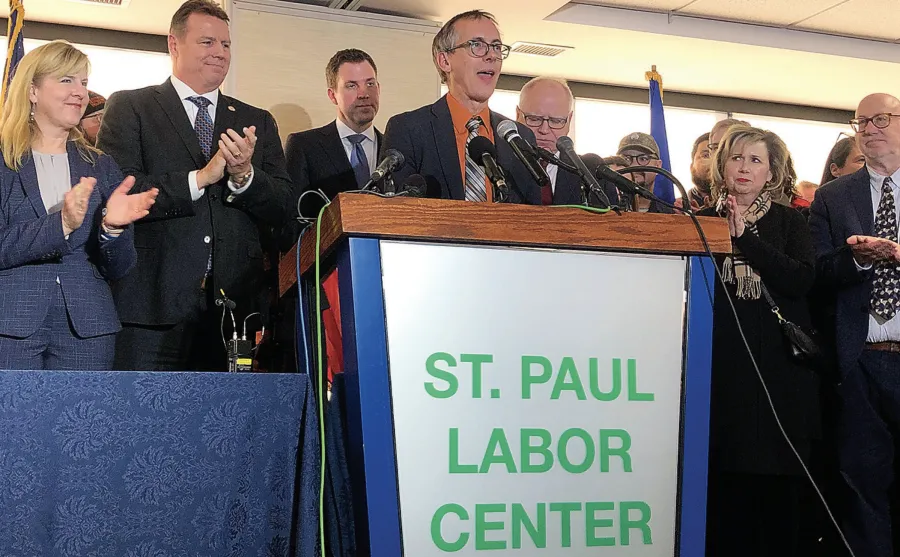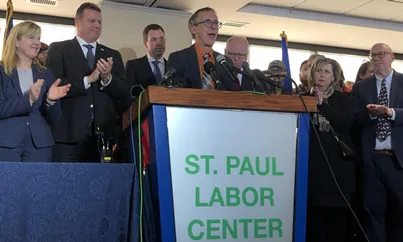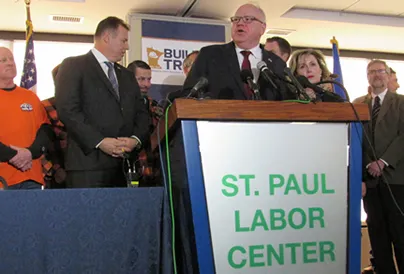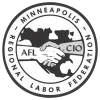Trades key to coalition winning new clean energy bill signed by Governor Walz

SAINT PAUL — Labor unions and environmental groups joined with Minnesota Governor Tim Walz and legislative leaders February 7 for a bill-signing ceremony at the Saint Paul Labor Center to celebrate historic clean energy legislation.
The bill, Senate File 4, puts Minnesota on a path to 100 percent carbon-free electricity by 2040 — while creating new clean energy jobs.
“Our children are counting on us to get this right,” said Governor Walz, addressing the packed meeting room at the Labor Center. “We can’t move too fast when it comes to addressing climate change.”
“It’s our skilled trades who are going to be building this future,” Walz emphasized.
Speaker of the House Melissa Hortman, in her remarks, noted that “a very strong coalition” worked to pass the bill, including labor, environmentalists, and young people.
“We have a climate crisis and we need to take action to address it,” she said.
“Today’s action is the strongest action Minnesota has taken on climate change. Full stop,” declared Representative Jamie Long (DFL-Minneapolis), who was the chief author of the bill in the Minnesota House. Kevin Pranis of the Laborers union (at microphone) addresses the crowd at the bill-signing ceremony.

Left to right: Speaker of the House Melissa Hortman; Senator Nick A. Frentz, chief Senate author; Representative Jamie Long, chief House author; Pranis; Governor Tim Walz.
“I want to thank in particular our labor partners,” Long stressed. No other state’s energy legislation has as strong labor standards as the Minnesota bill “to ensure jobs [created] will be good jobs,” Long said. “The bill we’re going to sign today can stand up to any clean energy bill in the country… “Minnesota’s energy leadership is back and here to stay.”
The bill’s chief Senate author, Senator Nick A. Frentz (DFL-Mankato), highlighted the work of labor and the state’s utilities as partners in developing the bill.
LIUNA Minnesota and North Dakota, representing five local Laborers unions, was an important backer of the bill.
“Our members recognize the world is changing and the time to act is now,” said Kevin Pranis, LIUNA Minnesota marketing director. “Our members are ready to put our skills and our world-class apprentice programs to work.”
In crafting the legislation, Pranis reported,“there was listening to workers… it was also listening to the workers who make the system run…”
“This is a lights-on bill,” Pranis maintained. “It’s going to accelerate plans to go build.”
The legislation will give the state’s Public Utilities Commission authority to fast-track wind energy and solar energy construction projects, Pranis said.
The bill also authorizes the PUC to require that workers who will construct those wind and solar projects will earn the state’s prevailing wage, and further directs the PUC to consider local job impacts when evaluating proposals.
Also under the bill, Pranis added, the state’s two nuclear power plants will apply to have their licenses extended, which will create construction work to get the plants ready for federal approval.
With labor standards included in the legislation, “we made sure jobs in clean energy will be just as good as conventional energy,” Pranis said. “We believe we’ll be the first state to actually get there.”
Xcel Energy regional president Chris Clark commented, “we’re already going to be building the state’s largest solar plant right next to our closing coal plant.” And, he added, “we’re going to find jobs for all our employees.”
Michael Noble, executive director of Fresh Energy, a group advocating for clean energy, offered tribute to organized labor for labor’s effort “to find common ground to make this bill happen.”

Flanked by union members, Governor Tim Walz (at podium) and legislative leaders celebrated the signing of clean energy legislation February 7 at the Saint Paul Labor Center.
